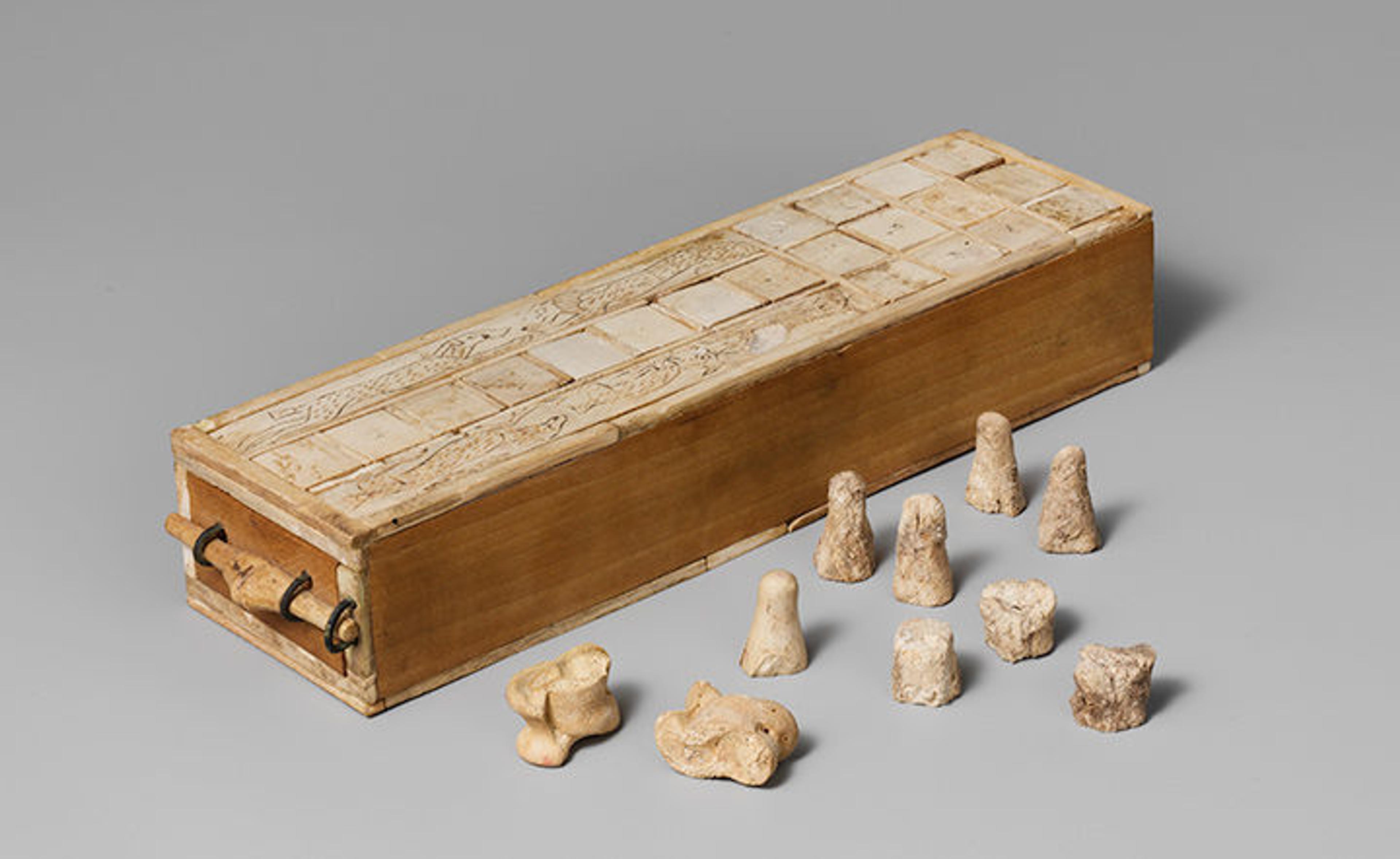What is your favorite board game? Senet was a very popular board game in ancient Egypt. Queens like Nefertari may have played it using a game box, while ancient Egyptians who were less wealthy may have played on a grid scratched into the floor. Do you like playing more than one kind of board game? So did the ancient Egyptians. They used game boards with the game senet on one side and the game of twenty squares on the other. Discover more about how and why ancient Egyptians played these games.
Senet

Game board and gaming pieces, ca. 1550–1295 B.C. From Egypt, Abydos, Cemetery D. Faience, modern wood. Restored box: L. 17 x W. 5 3/8 x H. 3 5/8 in. (43 x 13.5 x 9 cm). The Metropolitan Museum of Art, New York, Gift of Egypt Exploration Fund, 1901 (01.4.1a, game board; 01.4.1b–h, seven spool-shaped gaming pieces; 01.4.1i–p, eight conical gaming pieces)
What do you see?
This game box has 30 squares for the game senet. What do you notice about the tiles on the game board? The original tiles and fragments were found in an ancient Egyptian tomb along with game pieces shaped like cones and spools. They are made of faience (fay-AHNCE), a ceramic material that was often produced in a blue or blue-green color that symbolized life. Conservators have filled in missing tiles and parts of tiles with modern material. You can see the difference, because the color of the original faience appears darker while the modern ceramic material is a lighter blue. The conservators also used modern wood to reconstruct the box that held the tiles.

Grid for senet with the squares numbered 1–30. Illustration by Emily Sutter
How do you play?
The game was complicated. Two players determined their moves by throwing casting sticks or bones. A game piece started at square 1 on the upper left and zig-zagged across each row and down to the next, until it crossed square 30 on the bottom right. Each player could make moves to advance a piece and pass other pieces on the board. Each player could also block other pieces from moving forward or force their opponent backwards.

Top of the senet board (01.4.1a) showing the sign for "good" three times (read neferu) in square 26, and the word for water (mu) in square 27
The last five squares (squares 26–30) are usually decorated. On the board above, two marked squares are preserved and a third one is fragmentary. Square 26 is usually marked with the sign for "good" (nefer). Landing in this special square gave the player a free turn. It seems that the players had to reach this sign before they could move on to win the game. Square 27 on this senet board depicts a water hazard. If a game piece landed on this special square, it was removed from the grid before it could cross the final square on the bottom right. Players competed to cross the final square with all of their pieces.
Why is this game important?
Game boxes and depictions of senet are found in a number of tombs. Queen Nefertari is shown playing this game on the wall of her tomb, and King Tutankhamun was buried with no fewer than five game boxes. The ancient Egyptians believed in an afterlife, which means an existence after death. To reach the afterlife, a person who died had to perform certain rituals and pass many obstacles. In the New Kingdom, the game senet, which means "passing," became associated with the journey to the afterlife. Some of the squares of the game corresponded to the hazards a person might meet on their journey to the afterlife, while other squares helped the players. Because of this connection, senet was not just a game; it was also a symbol for the struggle to obtain immortality, or endless life.
Twenty Squares

Game box for playing the senet and twenty squares games, ca. 1635–1458 B.C. From Egypt, Thebes. Ivory, copper alloy, modern wood, L. 9 7/8 x W. 2 5/8 x H. 2 in. (25 x 6.7 x 5 cm). The Metropolitan Museum of Art, New York, Rogers Fund, 1916 (16.10.475a, game box; 16.10.475b–I, eight original gaming pieces; 16.10.475j–k, two knucklebones)
What do you see?
"Twenty squares" (or simply "twenty") is also played with a game board. Look at the piece of ivory at the end of this box. It fastens the drawer that holds the playing pieces. Next to the box are two knucklebones—the anklebones of animals like sheep—and game pieces that are shaped like cones and spools. The game board shown here is divided into twenty squares.
How do you play?
Like senet, "twenty squares" was a two-person game. The players rolled knucklebones to determine how to move the game pieces. Depending on how the two players rolled the knucklebones, they could play game pieces on the board. They raced each other down the center row of squares to win.
Why is this game important?
"Twenty squares" was popular across the ancient Near East from the Mediterranean Sea to Iran. It was imported to Egypt from the Near East over 3,500 years ago. Not all of the game boxes uncovered by archaeologists show markings on the special squares, because sometimes the markings have worn off. When the markings are preserved, researchers find flower-shaped rosettes on the squares on game boxes that come from the Middle East. But on game boxes from Egypt, they find hieroglyphs on the special squares instead of rosettes. This shows that the ancient Egyptians adapted the game to their taste.
Redesign your favorite board game. Using a blank sheet of paper, draw the grid for the game. Then, decorate the special squares or the space around the grid. What special designs will you choose?
